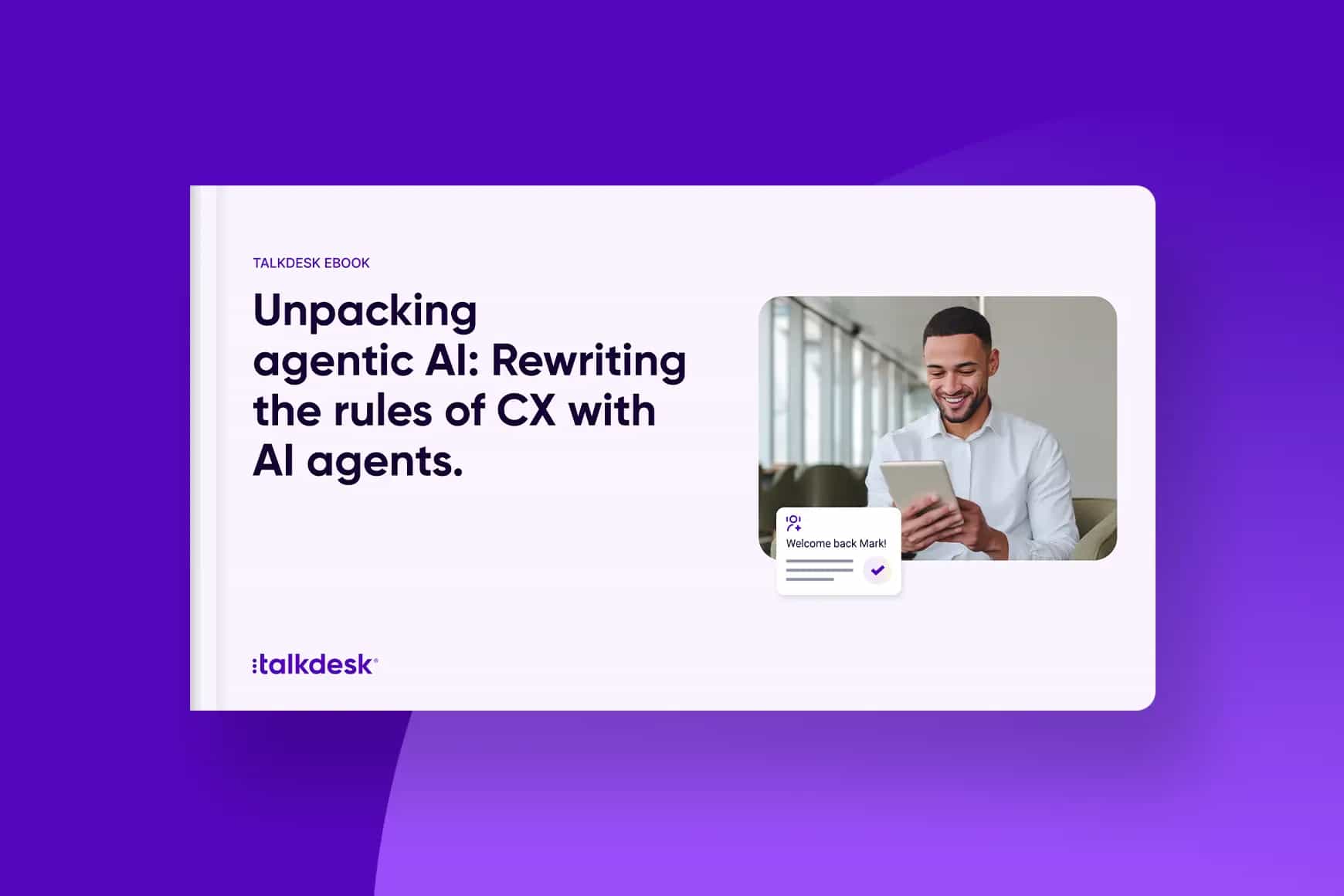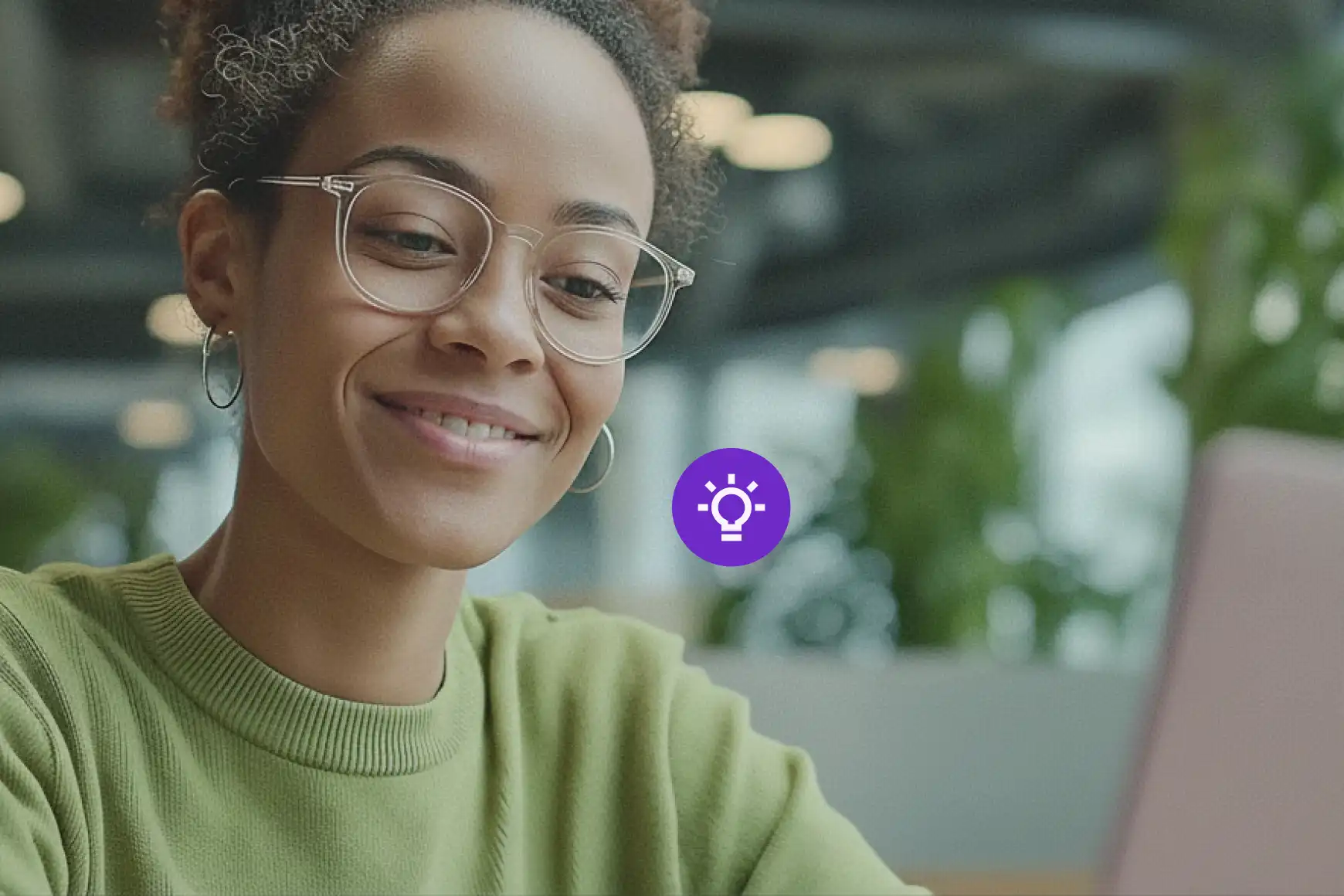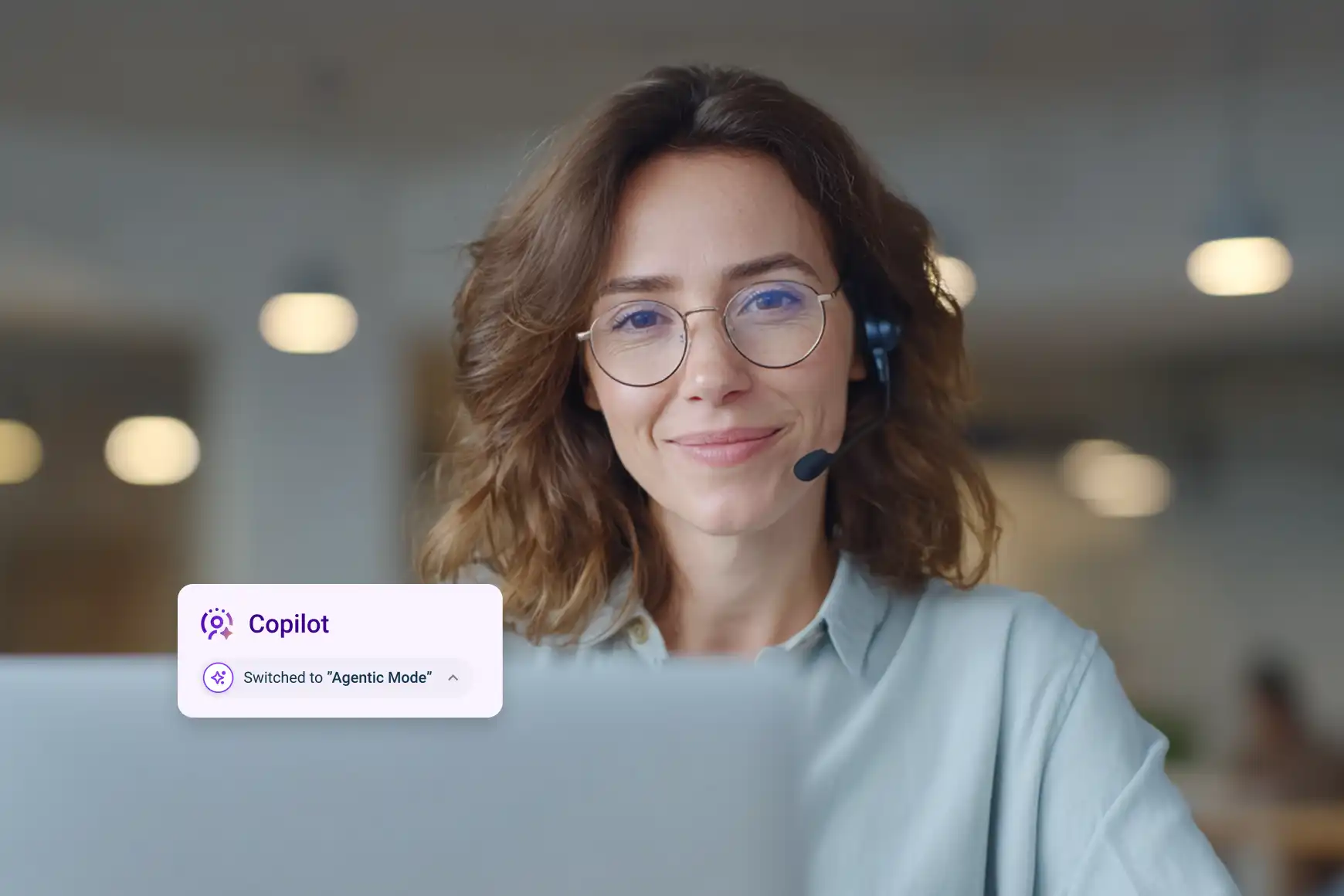What is a virtual agent? A comprehensive guide

By Celia Cerdeira
0 min read

Virtual agents leverage advanced AI to autonomously understand and respond to customer needs in real time—delivering fast, personalized 24/7 support.
Today’s customers turn to live chat environments, phone calls, or online knowledge bases as they search for answers to common questions. They might reach out to inquire about the status of their order, cancel a transaction, or request a refund.
Because many of these inquiries are repetitive and quick to solve, it can be tedious and time-consuming for a live agent to manage them. So instead of expecting human agents to handle all of these requests, contact centers implement virtual agents. They provide customer service and answer simple inquiries. If needed, they can escalate to a live human to respond to more complex issues.
In this article, we’ll explore the different types of virtual agents, their key benefits, and how they can enhance both customer and agent experiences.
What is a virtual agent?
A virtual agent is an AI-powered software tool that mimics human interactions to assist users, answer questions, and handle tasks across platforms like websites, apps, chat, and voice. These agents blend machine learning with natural language understanding to deliver fast, scalable support in real time. Virtual agents help organizations by saving the human agents’ time and by keeping contact center staffing costs lower for the organization.
Interactive voice response (IVR) is one of the earliest examples of a virtual agent. An IVR allows callers to select from a menu of automated prompts and then routes them to the most relevant resource. This process provides clues into the complexity of the inquiry. An IVR system can decide whether to route the caller to a live human. Today’s virtual agents use agentic AI, making them much more advanced than an IVR.
So, what powers virtual agents? A blend of intelligent technologies works together to craft accurate and responsive service. Here are a few of the core technologies that drive virtual agent performance:
-
Natural language processing (NLP). NLP enables virtual agents to understand and interpret human language so they can accurately identify intent and respond conversationally.
-
Artificial intelligence (AI). AI equips virtual agents to learn from past interactions, make decisions, and continuously improve responses.
-
Robotic process automation (RPA). RPA helps virtual agents complete repetitive back-end tasks, such as pulling up account data or submitting refund requests, without human involvement.
-
Large language models (LLMs). LLMs enable more advanced conversational capabilities, allowing virtual agents to understand context, generate human-like responses, and handle more nuanced interactions.
-
Sentiment analysis. Sentiment analysis helps virtual agents gauge customer emotions and adjust their tone or escalate issues to human agents when frustration or confusion is detected.
These technologies make virtual agents more capable and responsive, drastically improving the customer experience. As a result, contact centers are increasingly turning to virtual agents to handle routine tasks while freeing human agents for more complex conversations.

EBOOK
Unpacking Agentic AI: Rewriting the rules of CX with AI Agents.
In this new era of customer experience, AI agents combine the language mastery of generative AI with the autonomy of agentic AI to deliver smarter, faster, and more scalable support. They don’t just assist your team—they become part of it.
What are the major types of virtual agents?
Virtual agents come in a few different forms, each designed for a specific job. Some are great at cutting costs by handling high volumes of simple tasks. Others focus on creating a smoother, more natural customer experience. Let’s break down the main types of virtual agents.
Virtual voice agents respond to customer calls.
Virtual agents handle inbound phone calls and guide customers through their questions or requests. While traditional interactive voice response (IVR) systems were once the norm, today’s virtual voice agents go far beyond simple phone trees.
Thanks to agentic AI, voice agents can:
-
Analyze customer speech and intent using natural language understanding (NLU), natural language processing (NLP), and natural language generation (NLG).
-
Respond automatically to common requests—no human agent required.
-
Escalate to a live agent when an issue is too complex or emotional for automation.
Unlike traditional IVR systems, virtual agents engage in natural, free-flowing conversations—no menus, no button-pressing. Customers speak in their own words, and the agent understands, responds, and adapts in real time, just like a human assistant.
Virtual chat agents, or chatbots, engage customers through live messaging.
Virtual chat agents operate in text-based environments, such as live chat windows, mobile apps, or social messaging platforms. Since many customers prefer to type rather than talk, chatbots have become an essential part of contact center operations.
These agents use conversational AI to quickly identify customer needs and respond with relevant information. Plus, just like their voice-based counterparts, chatbots can escalate the conversation to a live agent, if needed.
Virtual chat agents offer many benefits for both customers and contact center teams, including:
-
24/7 support. Customers can get help at any time, even outside of regular business hours.
-
Faster response times. Chatbots reply instantly, keeping customers from waiting in long queues.
-
Multitasking power. Virtual agents can handle multiple chats at once—something human agents can’t.
-
Reduced agent workload. By managing routine or repetitive questions, chatbots free up human agents to handle more complex inquiries.
-
Improved customer satisfaction. Quick, accurate answers lead to smoother customer experiences.
Overall, virtual chatbots help streamline support and make the experience more convenient for everyone involved.
Copilots learn from interactions to provide tailored advice.
Rather than interacting directly with customers, copilots work behind the scenes during live interactions, offering real-time guidance, suggestions, and information to help agents deliver faster, more accurate service.
Powered by advanced AI, copilots learn from previous interactions, customer context, and ongoing conversation patterns to offer personalized recommendations. Consider these key features of copilots:
-
Real-time guidance. Offers live prompts, next-best actions, or response suggestions based on the flow of the conversation
-
Contextual awareness. Understands the customer’s intent, sentiment, and interaction history to tailor support.
-
Learning and improvement. Continuously improves over time by learning from agent decisions and outcomes.
-
Workflow automation. Triggers back-end processes like updating tickets or sending follow-up emails without manual input.
By working alongside human agents, copilots boost productivity, improve response quality, and help reduce time-to-resolution.
AI agents collect data and perform tasks to achieve specific goals.
AI agents take virtual support to the next level by atcting independently to achieve specific outcomes. Unlike traditional chatbots, which follow scripts or rules, AI agents can interact with their environment, interpret real-time data, and make decisions on their own without human input.
These agents are designed to manage entire workflows from start to finish. For example, an AI agent might receive a customer complaint, assess sentiment, retrieve account history, and follow up with a personalized message—on its own. By “thinking” through problems and choosing actions based on goals and context, AI agents save organizations time and money.
Here are a few standout capabilities that make agentic AI so powerful:
-
Autonomous behavior. AI agents operate independently, taking the initiative to complete tasks without waiting for step-by-step instructions.
-
Advanced reasoning. They evaluate multiple data points and potential outcomes to make informed, goal-oriented decisions.
-
Learning for improved performance. These agents improve over time by learning from interactions and outcomes, becoming more efficient and accurate with continued use.
Personalization, issue resolution, and other virtual agent features.
From delivering personalized experiences to resolving issues in real time, virtual agents come packed with powerful features designed to enhance customer satisfaction.
Hyper-personalized customer service.
Hyper-personalization in customer service goes beyond using a customer’s name or purchase history; it tailors every interaction based on real-time data, behavior, and preferences. Virtual agents help deliver this by tapping into CRM data, past interactions, and customer sentiment to provide highly relevant responses. The most advanced virtual AI agents take this further, using autonomous decision-making and deep learning to anticipate customer needs and resolve issues before a person even asks for help.
Compared to generic service, hyper-personalized interactions lead to faster support, stronger relationships, and higher satisfaction. It’s no surprise that businesses are prioritizing it. According to a study by Dynamic Yield by Mastercard, 67% of surveyed companies have made personalization a top priority and plan to invest further in it.
Learn more about how hyper-personalization enhances the customer experience.
Conversational interactions.
Virtual agents aren’t just rule-following bots. They’re smart, responsive, and surprisingly human-like. Powered by AI, virtual agents are becoming flexible and friendly, capable of holding natural conversations that make customers feel heard and understood. They can interpret intent, respond with empathy, and handle increasingly complex requests.
This level of sophistication elevates the customer experience. Whether it’s helping with account issues, tracking orders, or walking someone through a troubleshooting step, conversational virtual agents can guide the interaction in a way that feels intuitive and seamless.
They’re also multilingual. AI virtual agents can engage customers in their preferred language—automatically detecting and switching as needed. This multi-language support improves accessibility and inclusivity while helping global businesses build trust and deliver consistent service across different markets.
Intelligent human handoff.
Even the smartest virtual agents know when to bring in a human. By analyzing customer intent, sentiment, and complexity, they can recognize when a situation calls for live support.
Rather than forcing the customer to start over, the virtual agent ensures a seamless handoff, passing along the full context of the interaction, including the customer’s issue, previous conversations, and any steps already taken. This saves time and reduces frustration, so human agents can jump in with the right information and resolve issues faster.
Automated, omnichannel customer service.
Virtual agents aren’t limited to one channel. Whether it’s over the phone, in a live chat window, or through email, virtual agents can deliver consistent omnichannel support.
For instance, on a phone call, a virtual voice agent might quickly verify a customer’s identity or handle a password reset. In a live chat, it could walk a user through troubleshooting steps in real time. Over email, a virtual agent might respond with helpful resources or process a refund request automatically. With the help of CRM integrations, virtual agents can also tap into customer profiles and past interactions to personalize each conversation.
What are the benefits of virtual agent technology?
By handling routine interactions, scaling support across channels, and delivering fast, personalized assistance, virtual agents help organizations build a winning customer experience strategy.
Here are some of the most powerful benefits virtual agents bring to the customer experience:
-
Better efficiency. Virtual agents handle high volumes of routine requests, allowing human agents to focus on more complex tasks.
-
Contextual service. By accessing customer history and CRM data, virtual agents tailor their responses to each customer’s situation.
-
Improved customer satisfaction. Faster, more accurate support leads to smoother experiences and stronger customer relationships.
-
Always-available support. Virtual agents provide 24/7 service, ensuring customers can get help anytime, regardless of business hours.
-
Shorter wait and resolution times. By answering questions instantly and resolving simple issues on the spot, virtual agents reduce wait times and improve time-to-resolution.
-
Lower operational costs. Automating support at scale reduces the need for additional headcount while increasing service capacity.
-
Scalable support. Virtual agents can engage with thousands of customers at once—something no human team could achieve alone.
Exploring virtual agent use cases.
No matter the industry, virtual agents are helping organizations deliver outstanding customer service. Let’s get into how virtual agents are used across different industries and the specific ways they’re driving value.
Virtual agents in healthcare.
In healthcare, delivering timely, personalized support is critical—and virtual agents are helping providers meet that demand. By automating routine tasks like appointment scheduling, prescription refills, and benefits inquiries virtual agents enable human agents to focus on patient care. AI-powered virtual agents also enable hyper-personalized patient journeys. They can access patient history, preferences, and care plans to deliver tailored information and reminders, ensuring each patient receives the right support at the right time.
One example is Memorial Healthcare System, one of the largest public healthcare systems in the U.S. Facing challenges across 12 separate, disconnected contact centers, Memorial uses Talkdesk Healthcare Experience Cloud, which includes a virtual agent integration with Epic’s EMR.
The results are impressive: average time to answer dropped by 47%, abandonment rate decreased by 69%, and average handle time (AHT) was reduced by 24%. With Talkdesk Autopilot, more than 50% of password reset calls and 16% of appointment management tasks were handled entirely by a virtual agent—saving time, cutting costs, and delivering a better patient experience. Watch this webinar to learn more.
Virtual agents in banking.
In banking and financial services, customers expect fast, secure, and highly personalized support. Virtual agents help banks meet those expectations by automating routine inquiries—like checking balances or resetting passwords—while also providing more conversational, human-like assistance through advanced AI.
Banks are also using virtual agents to engage customers in natural dialogue, improving the overall experience while maintaining strict security and compliance standards. With CRM integration and conversational AI, these agents can tailor responses based on account history, product usage, or recent transactions, making self-service not only more accessible but more intelligent.
An example is Collins Community Credit Union, which serves members across Iowa, Illinois, and Wisconsin. After implementing Talkdesk Financial Services Experience Cloud and launching Talkdesk Autopilot, the credit union dramatically streamlined operations.
By automating responses to FAQs, they reduced call volume by over 50,000 calls in a single year—dropping from 182,000 to 130,000. Their abandonment rate was also cut in half, from 30% to 14.5%. With a unified member experience and smarter support tools, Collins Community Credit Union improved efficiency while staying true to its mission of “people helping people.”
Virtual agents in retail.
In retail, fast answers, personalized support, and seamless experiences across channels are now the norm. Virtual agents help retailers meet those demands by handling common inquiries like order tracking, return status, product availability, and store information instantly and accurately. They also play a key role in pre-purchase support, helping guide shoppers to the right products through conversational, AI-powered interactions.
Farfetch, a global luxury fashion marketplace operating in over 190 countries, implemented Talkdesk Retail Experience Cloud to power its support operations. The result was a 30% increase in workload and only a 12% increase in payroll, thanks to major gains in productivity and scalability. Farfetch achieved cost efficiencies of around 40%—with half of that directly tied to using Talkdesk Retail Experience Cloud. By leveraging virtual agents and automation, they’re scaling their customer support globally without sacrificing quality.
Use virtual agents to level up your customer experience today.
Virtual agents are key to delivering modern customer service. Across industries, they’re helping organizations scale support, reduce operational costs, and deliver more personalized experiences. From answering routine inquiries to supporting agents in real time and even handling entire workflows autonomously, virtual agents are transforming how businesses connect with their customers.
Ready to bring AI-powered support to your contact center? Explore Talkdesk AI Agents and see how virtual agents can help you unlock faster, smarter, and more cost-effective customer service.
Virtual agent FAQs.
Check out our answers to the most common questions about virtual agents below.
A virtual agent is a software-powered assistant that uses AI and automation to communicate with customers and help resolve their issues. It can operate across channels like phone, chat, email, or messaging apps to deliver fast, efficient support.
Virtual agents use technologies like natural language processing (NLP), machine learning, and backend integrations to understand customer intent and provide relevant responses. They can complete tasks, retrieve information, and escalate issues to human agents when necessary.
A chatbot typically follows scripted rules and handles simple queries, while a virtual agent uses AI to understand context, learn from interactions, and manage more complex conversations. Virtual agents are more dynamic, responsive, and capable of personalization.
Virtual agents improve efficiency, reduce wait times, offer 24/7 support, and free up human agents for more complex tasks. They also enhance customer satisfaction by delivering faster, more personalized service at scale.
While virtual agents are powerful, they may struggle with highly emotional, nuanced, or unexpected scenarios that require human judgment. That’s why intelligent escalation to a live agent remains a key part of any virtual agent strategy.
Virtual agents can support live agents by handling routine inquiries, gathering customer context, and surfacing relevant information in real time. They can also suggest responses and automate repetitive tasks, helping agents work more efficiently.





